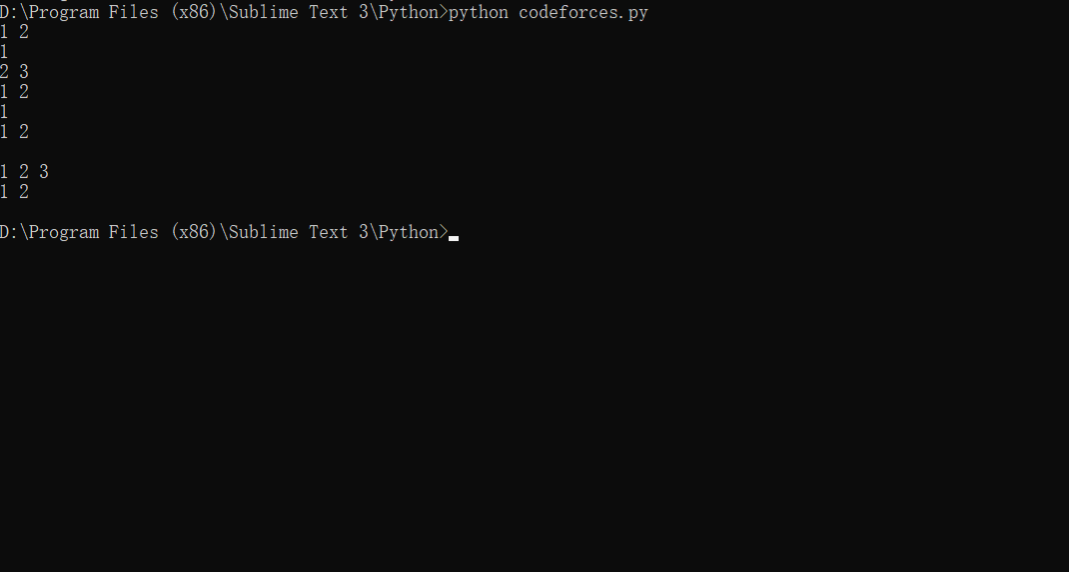列表
1、将列表中的字符型数字转换为数值类型
1
2
3
4
5
6
7
| lis = ['1', '2', '3', '8', '6', '12']
num_lis = [int(x) for x in lis]
num_lis = list(map(int, lis))
输出结果为:[1, 2, 3, 8, 6, 12]
|
2、将列表中的数字转换为字符(同上)
1
2
3
4
5
6
7
| lis = [1, 2, 3, 8, 6, 12]
char_lis = [str(x) for x in lis]
char_lis = list(map(str, lis))
输出结果为:['1', '2', '3', '8', '6', '12']
|
3、对列表中的元素进行排序
1
2
3
4
5
6
| lis = [1, 2, 3, 8, 6, 12]
lis.sort()
print(lis)
输出结果为:[1, 2, 3, 6, 8, 12]
|
- 如果列表中是字母型字符,那么也直接进行排序(根据ASCII):
1
2
3
4
5
6
| lis = ['a', 'd', 'e', 'b']
lis.sort()
print(lis)
输出结果为:['a', 'b', 'd', 'e']
|
- 如果列表中是数字型字符,想要使其中的数字升序或者降序排列,需要对其进行一些操作:
1
2
3
4
5
6
7
|
lis = ['1', '2', '3', '8', '6', '12']
lis.sort()
print(lis)
输出结果为:['1', '12', '2', '3', '6', '8']
|
注意:上述排序是按元素的第一个字符进行排序的。
1
2
3
4
5
6
| lis = ['1', '2', '3', '8', '6', '12']
lis.sort(key=lambda x:int(x))
print(lis)
输出结果为:['1', '2', '3', '6', '8', '12']
|
4、Python 输出时去掉列表或者元组外面的方括号与圆括号
可以是使用**join()**函数来实现:
‘x’.join(y),x可以是任意分割字符,y是列表或元组。以列表为例,可以将列表中的每一个元素两头的引号给去
除,同时,元素与元素之间以字符‘x’作为分割标志,并且列表最外面的中括号也能去除掉。元组同理。
1
2
3
4
5
| lis = ['1', '2', '3', '8', '6', '12']
print(' '.join(lis))
输出结果为:1 2 3 8 6 12
|
注意:join()函数只能用于字符,不能用于数值类型。
5、列表的去重和排序
先将一个列表转换为set集合, 再转换为list列表,即可完成去重。
1
2
3
4
5
| lis = [1, 2, 3, 12, 8, 6, 3]
print(list(set(lis)))
输出结果为:[1, 2, 3, 6, 8, 12]
|
- 若列表元素为字符,则只可以去重不可以排序,顺序为随机排列:
1
2
3
4
5
| lis = ['1', '2', '3', '8', '6', '12', '3']
print(list(set(lis)))
输出结果为:['6', '3', '12', '1', '2', '8']
|
字典
- python字典以键值对的形式存储,且键一般是唯一的,如果重复,则最后的一个键值对会替换前面的,值不需要唯一。
- 值可以取任何数据类型,但键必须是不可变的(字符串,数字,元组)。
删除字典元素
1
2
3
4
5
| dict = {'Name': 'Zara', 'Age': 7, 'Class': 'First'}
del dict['Name']
dict.clear()
del dict
|
遍历字典元素
1
2
3
4
5
6
7
8
9
10
11
12
13
| dic= {'Name': 'Zara', 'Age': 7, 'Class': 'First'}
for key in dic.keys():
print(key)
for val in dic.values():
print(val)
for key, val in dic.items():
print(key, val)
|
其他方法
| 序号 |
函数及描述 |
| 1 |
dict.has_key(key) 如果键在字典dict里返回true,否则返回false |
| 2 |
dict.update(dict2) 把字典dict2的键/值对更新到dict里 |
| 3 |
dict.get(key) 返回指定键的值,如果值不在字典中返回default值 |
| 4 |
dict.update(dict2) 把字典dict2的键/值对更新到dict里 |
| 5 |
pop(key,default) 删除字典给定键 key 所对应的值,返回值为被删除的值。key值必须给出。 否则,返回default值。 |
数值处理
1、python向上取整,向下取整,四舍五入
1
2
3
4
5
6
| import math
f = 5.49
print(math.ceil(f))
print(math.floor(f))
print(round(f))
|
2、输出规定数位的小数
1
2
3
4
5
6
| #结果保留两位小数
x = 2.3333333
print("%.2f" %x)
输出结果为:2.33
|
3、输出多个相同的值
1
2
3
4
5
|
print("python"*3)
输出结果为:pythonpythonpython
|
4、函数有任意多个参数
将函数的参数定义为*n,n可以看作一个列表,接收实际参数。
例如定义一个函数multi()可以传入任意个参数,返回这些参数的乘积:
1
2
3
4
5
6
7
8
| def multi(*n):
multi = 1
for x in n:
multi *= x
return multi
print(multi(1,2,3))
输出结果为:6
|
将函数的参数定义为**n,n可以看作一个字典,接收实际参数。
1
2
3
4
5
| def dictionary(**n):
print(n)
dictionary(first=1, second=2, third=3)
输出结果为:{'first': 1, 'second': 2, 'third': 3}
|
循环输入
怎么样能使while循环和input输入结合起来形成循环输入呢?python不能像C语言那样直接实现
1
| while(scanf("%d%d", &a,&b) != EOF)
|
在python中,无法通过input()的返回值判断是否有EOF。python是通过抓取异常来知EOF的,于是,通过try except的方法,当出现except的时候,就是到了EOF,这时退出循环。
1
2
3
4
5
6
7
8
9
| while True :
try :
x = int(input())
y = int(input())
print(x+y)
except :
break
|
1
2
3
4
5
6
7
8
9
| while True :
try :
s = input()
l = s.split()
print(int(l[0])+int(l[1]))
except :
break
|
注意:引起异常的并不是input()本身,而是紧跟在input()函数后调用输入值的语句:print(x+y)和print(int(l[0])+int(l[1])),因为当不从键盘上输入值即input()函数返回None时,后面的语句调用输入值时发生错误从而引发异常。若将print(x+y)和print(int(l[0])+int(l[1]))语句删去,将形成无限循环输入。
在此附上一个例子:
进行两个集合的合并,并且没有重复元素且升序排列。
输入:若干组,每组包括三行,第一行输入两个数字,分别为两个集合的元素个数;第二行和第三行分别为两个集合。
输出:若干组,每组一行,为合并后的集合。
1
2
3
4
5
6
7
8
9
10
11
12
13
14
| result = []
while True:
try:
x = input().split()
x[0]
except:
break
else:
set1 = input().split()
set2 = input().split()
result.append(list(set(set1+set2)))
for i in range(0, len(result)):
result[i].sort(key=lambda d:int(d))
print(' '.join(result[i]))
|
结果为:

时间格式转换
导入包:
1
| from time import datetime
|
datetime格式转换为字符串:
1
2
| time = datetime.now()
time_str = datetime.strftime(time, "%Y-%m-%d %H:%M:%S")
|
字符串转换为datetime格式
1
2
| str = "2020-8-1"
time = datetime.strptime(str, "%Y-%m-%d")
|
正则表达式
导入
使用
re.match函数
re.match 尝试从字符串的起始位置匹配一个模式,如果不是起始位置匹配成功的话,match()就返回none。
1
2
3
4
5
| re.match(pattern, string, flags=0)
|
该函数返回一个match对象(如果匹配失败,返回None),如果想要得到匹配到的字符串。可以使用group()函数或groups()函数。
| 匹配对象方法 |
描述 |
| group(num=0) |
匹配的整个表达式的字符串,group() 可以一次输入多个组号,在这种情况下它将返回一个包含那些组所对应值的元组。 |
| groups() |
返回一个包含所有小组字符串的元组,从 1 到 所含的小组号。 |
例如:
1
2
3
4
5
6
7
| import re
pattern = "\w+123"
string = "skdgh123"
print(re.match(pattern, string).group())
输出为:skdgh123
|
re.search函数
re.search 扫描整个字符串并返回第一个成功的匹配。
1
2
3
| re.match(pattern, string, flags=0)
|
re.sub函数
Python 的 re 模块提供了re.sub用于替换字符串中的匹配项。
1
2
3
4
5
6
| re.sub(pattern, repl, string, count=0, flags=0)
|
例如:
1
2
3
4
5
6
7
| import re
string = "hello world!"
result = re.sub('world', 'gays', string)
print(result)
输出为:hello gays!
|
re.compile函数
compile 函数用于编译正则表达式,生成一个正则表达式( Pattern )对象,供 match() 和 search() 这两个函数使用。
1
2
3
4
5
6
7
8
9
10
| re.compile(pattern, flags)
re.I 忽略大小写
re.L 表示特殊字符集 \w, \W, \b, \B, \s, \S 依赖于当前环境
re.M 多行模式
re.S 即为 . 并且包括换行符在内的任意字符(. 不包括换行符)
re.U 表示特殊字符集 \w, \W, \b, \B, \d, \D, \s, \S 依赖于 Unicode 字符属性数据库
re.X 为了增加可读性,忽略空格和
|
例如:
1
2
3
4
5
6
7
8
| import re
string = "hello world!"
pattern = re.compile(r'hello')
result = pattern.match(string)
print(result.group())
输出为:hello
|
findall函数
在字符串中找到正则表达式所匹配的所有子串,并返回一个列表,如果没有找到匹配的,则返回空列表。
1
2
3
4
5
| findall(string, pos, endpos)
|
例如:
1
2
3
4
5
6
7
8
| import re
pattern = re.compile(r'\d+')
result1 = pattern.findall('runoob 123 google 456')
result2 = pattern.findall('run88oob123google456', 0, 10)
print(result1)
print(result2)
|
输出结果:
1
2
| ['123', '456']
['88', '12']
|
正则表达式对象
re.RegexObject
re.compile() 返回 RegexObject 对象。
re.MatchObject
group() 返回被 RE 匹配的字符串start() 返回匹配开始的位置end() 返回匹配结束的位置span() 返回一个元组包含匹配 (开始,结束) 的位置
replace替换字符串
Python replace() 方法把字符串中的 old(旧字符串) 替换成 new(新字符串),如果指定第三个参数max,则替换不超过 max 次。
1
2
3
4
5
| str.replace(old, new, max)
|
返回值:返回字符串中的 old(旧字符串) 替换成 new(新字符串)后生成的新字符串。
例如:
1
2
3
4
| string = "hello world!"
print(string.replace('world', 'gays'))
输出为:hello gays!
|
全局变量
在python中,假设x是一个全局变量,那么在一个函数内(该函数未定义局部变量x)使用类似x += 1、x = max(x, 0)等语句时,会报错:UnboundLocalError: local variable ‘x’ referenced before assignment
例如:
1
2
3
4
| x = 0
def f():
x += 1
f()
|
解决方法:在函数中使用该全局变量前用globle进行声明即可
1
2
3
4
5
6
| x = 0
def f():
global x
x += 1
print(x)
f()
|
未完待续······
